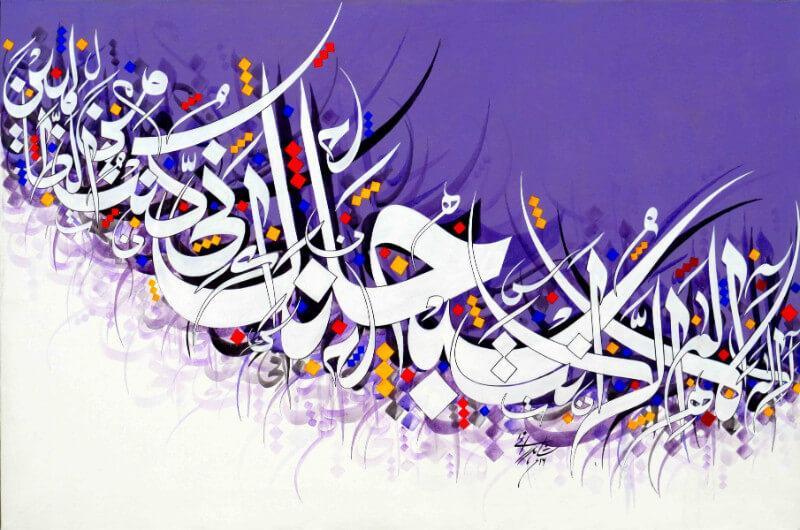Arabic calligraphy, also known as Masqlaseen, is a breathtaking form of artistic expression that has been cherished for centuries in the Arab world. It goes beyond mere writing and transforms Arabic script into a mesmerizing visual art. Rooted in the Islamic tradition, Masqlaseen holds immense significance in the realms of culture, religion, and artistic heritage. This art form has captivated hearts, transcended borders, and continues to inspire artists and enthusiasts worldwide.
Historical Roots and Evolution:
The origins of Arabic calligraphy can be traced back to the early days of Islam, particularly during the lifetime of Prophet Muhammad (peace be upon him). Arabic script was considered sacred as it was used to record the divine revelations in the form of the Quran. Initially, calligraphy served as a medium for transcribing the holy text, but it gradually evolved into an art form that reflected the profound reverence for the word of God.
The Islamic Golden Age, between the 8th and 14th centuries, played a pivotal role in shaping Masqlaseen into a highly esteemed art form. Scholars and artists during this period made significant advancements in the aesthetics of Arabic calligraphy, introducing various scripts and styles. Prominent calligraphers such as Ibn Muqla, Ibn al-Bawwab, and Yaqut al-Musta’simi elevated the art to new heights, leaving a lasting legacy that still inspires modern practitioners.
Fundamentals of Masqlaseen:
Masqlaseen is characterized by its deep-rooted connection to Arabic script and the principles of Islamic art. Central to its essence are three foundational elements:
- The Arabic Script: The Arabic language and its script are central to Masqlaseen. The beauty of the calligraphy lies in the flowing, interconnected strokes that form each letter, word, and phrase. The fluidity of the script allows artists to create harmonious compositions that convey the beauty of the message they represent.
- The Spiritual Essence: Arabic calligraphy is deeply rooted in Islam, and many of the scripts are used to transcribe verses from the Quran or hadith (sayings of the Prophet Muhammad). Calligraphers approach their work with a sense of spiritual devotion, aiming to reflect the divine message in their art. The spirituality behind Masqlaseen adds an extra layer of meaning and significance to the art form.
- Aesthetic Harmony: The calligrapher seeks to create a harmonious and balanced composition, often incorporating various script styles and decorative elements. The art conveys not only the words’ meaning but also the emotions and moods they evoke.
Styles and Scripts:
Arabic calligraphy boasts an array of intricate scripts, each with its own unique style and characteristics. Some of the most famous scripts include:
- Kufic: One of the oldest and most rigid scripts, Kufic features bold, angular letters and is often associated with early Quranic manuscripts and architectural inscriptions.
- Naskh: Naskh is one of the most widely used scripts due to its readability. It is often used in books and printed materials and is characterized by its rounded, clear, and elegant letters.
- Thuluth: Known for its elongated vertical lines and elaborate curves, Thuluth is a script often used for decorative purposes, especially in mosques and monuments.
- Diwani: Diwani is a highly decorative script with flowing and intertwined letters, often used in official documents, invitations, and certificates.
Significance and Modern Revival:
Masqlaseen has transcended its traditional roots and continues to thrive in the contemporary world. The artistic legacy of Arabic calligraphy has inspired a new generation of calligraphers, both in the Arab world and beyond. With advancements in technology, calligraphy has found new avenues of expression, including digital platforms, design, and typography.
Arabic calligraphy has also become an essential element in contemporary Islamic art. Modern artists combine traditional calligraphy with various mediums, such as painting, sculpture, and mixed media, to create innovative and captivating works of art. These artistic endeavors not only preserve the rich heritage of Masqlaseen but also contribute to the global appreciation of Islamic culture and art.
Conclusion:
Masqlaseen, the mesmerizing art of Arabic calligraphy, is a testament to the beauty, spirituality, and rich heritage of the Arab world. It has served as a vehicle for transmitting sacred texts and messages, preserving cultural identity, and inspiring artistic expressions. From its early beginnings during the Islamic Golden Age to its contemporary revival, Masqlaseen continues to enchant and captivate both practitioners and admirers worldwide. This timeless art form remains an enduring symbol of the profound connection between language, spirituality, and the aesthetic sensibilities of humanity.
